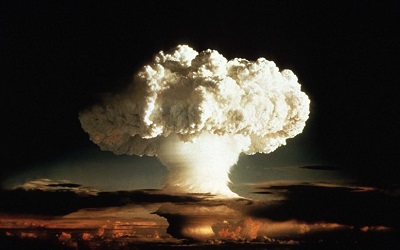Should we be preparing ourselves for nuclear emergency after the increasingly antagonistic (and absurd) exchanges between Donald Trump and Kim Jong-un? Some government agencies are starting to prepare for the worst through training and drills that have not been relevant since the Cold War.
On January 2nd, after returning from a vacation in Mar-a-Lago, Donald Trump resumed Tweeting and impacting international relations. Kim Jong-un raised some alarm bells earlier when he said that the US is “within the range of our nuclear strike and a nuclear button is always on the desk of my office.” In response, Trump tweeted, “Will someone from his depleted and food starved regime please inform him that I too have a Nuclear Button, but it is a much bigger & more powerful one than his, and my Button works!”
This talk is reminiscent of the heated exchange between Trump and North Korea over the summer. On July 4th, North Korea successfully launched an intercontinental ballistic missile that many believed was powerful enough to reach mainland US. On August 5th, the UN Security Council adopted harsh economic sanctions against North Korea in response to its missile tests. To worsen relations, Trump said that “any more threats to the United States” will prompt “fire and fury like the world has never seen.”
Despite the absurd character of these events, which many commentators have said are reminiscent of childish taunts, some organizations are treating them very seriously. Unification Minister Cho Nyoung-gyon from South Korea noted that the North has developed their nuclear capabilities faster than expected, and may be completed as early as 2018. Although there are strict protocols in place to prevent Trump from actually pushing his “bigger [and] more powerful” button on a whim, there are neither assurances that North Korea has such protocols nor certainty that Trump will haphazardly start that process.
For the past few months, some government agencies have been preparing themselves in case of a nuclear event. In August, during the most heated moments of nuclear rhetoric from the US and North Korea, Guam’s Homeland Security and Office of Civil Defense released a two-page fact sheet about how to prepare for an attack and what to do if it occurred. The prep includes making a list of concrete shelters near one’s home, school, or workplace to stay in, since the walls are often “thick and dense enough to absorb radiation given off by fallout particles.”
Similarly, in December Hawaii started monthly testing of a nuclear warning siren, which alerts residents of an impending nuclear strike. The system was first created during the Cold War in response to fears of a nuclear attack from the USSR. Notably, a warning system is most critical in Hawaii since it is only 4,700 miles from North Korea. Given the country’s current capabilities, Hawaii would only have about 20 minutes to respond to a missile launch.
Most recently, the Center for Disease Control (CDC) announced that it will have a grand rounds session on January 16 about how the public health sector can prepare for a nuclear event. Titled the “Public Health Response to a Nuclear Detonation,” the sessions teach health professionals how to lessen deaths and illnesses in the aftermath of the fallout. The sessions include topics like radiation preparedness and using data to drive response efforts. The CDC noted that, “[w]hile a nuclear detonation is unlikely, it would have devastating results and there would be a limited time to take critical protection steps.”
It is concerning that we seem to have suddenly entered a world where nuclear rhetoric is once again being used as a weapon of international relations – except this time, it is wielded by leaders who are known for their pride, haphazard decisions, and antagonistic approaches to global politics. Anything could set them off. Although part of me hopes that these events simply amount to sabre-rattling among schoolyard bullies, I can’t help but Google where the nearest shelter is…

